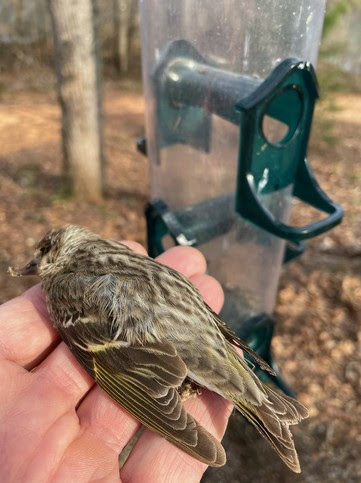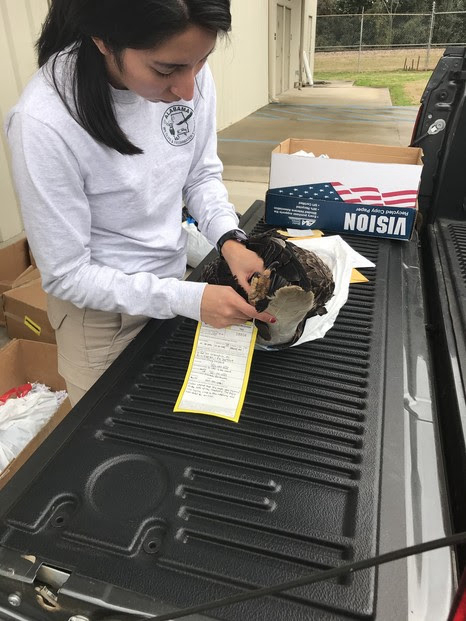Editor’s Note: Today’s feature was received from the Alabama Department of Conservation and Natural Resources. It’s good information for anyone with bird feeders.

Pine Siskins are one species that are being reported frequently as sick and dying birds are discovered at feeders throughout the state.
|
Winter weather offers a great opportunity to see a wide collection of birds at your feeders. While food resources are lower in winter, bird seed provided in your back yard is especially appetizing for resident birds that can be found here year-round and even more so for those birds who have migrated south for the winter. This year we have received reports of larger than normal flocks of wintering birds across the state congregating at feeders, including American goldfinches, purple and house finches, and pine siskins.
While bird feeders are useful in providing additional resources to many birds, they also can cause harm when disease issues arise. One such disease which is spread thru feces contamination is Salmonellosis. Signs that a bird is ill include ruffled feathers, lethargy, letting you approach them or even pick them up, or you may even find dead birds around your feeders. If you start to see birds acting strange or showing any of these signs, the best thing to do is to take your feeders down and disinfect them with a bleach solution. Leave the feeders down for a couple of weeks and rake up any excess feed that may be left in the yard. Also remove bird baths and clean them. This will allow the birds to disperse and lower the chances of salmonellosis spreading further. If you do find dead birds around your feeders, you can dispose of them by double bagging and placing them in a trash can.

Biologist Mercedes Maddox attaching an information tag to an eagle carcass in preparation for shipping to the National Eagle Repository
|
As the bald eagle population continues to expand, unfortunately, so do the number of instances an eagle is injured or killed by an anthropogenic force. While the bald eagle population is sufficiently stable to not be significantly impacted by these losses, it is still hard to see such a magnificent bird succumb to its injuries. Fortunately, due to the efforts of the National Eagle Repository, this death is not the end of an eagle’s story.
Initiated in Pocatello, Idaho, the National Eagle Repository was first created by the U.S. Fish and Wildlife Service in the 1970s to recognize the significance eagle feathers have to Native Americans. While the Bald and Golden Eagle Protection Act was enacted to deter the poaching of eagles, it also eliminated the access Native Americans had to eagle feathers and other parts of the birds that were used as components of their religious and cultural ceremonies. It wasn’t until 1994 that the eagle repository became what it is today. Now sitting at the Rocky Mountain Arsenal National Wildlife Refuge outside of Denver, Colorado, the repository serves as a central location for the receipt, storage, and distribution of deceased eagles. This was the result of a presidential mandate signed by President Clinton after he met with 300 tribal leaders that required all federal agencies to send deceased eagles to the repository. This new mandate provided an avenue to a legally regulated method that protects both eagles and the cultural rights of members of federally recognized Native American tribes.
Over the last 10 years, the repository has seen a 55% increase in the number of incoming bald eagles which correlates with the increase in nesting pairs in the U.S. Eagles sent to the repository for various reasons including collisions with either vehicles or powerlines and lead poisoning. In Alabama, the majority of eagles Alabama DWFF retrieve are a result of vehicular collisions. Once in hand, biologists collect all the necessary information on how, where, and when the bird died, then catalog that information on specific tags that get placed on the eagle’s leg, and mail the tagged eagle to the repository.
So, while it may seem like an eagle's story ends at death, with the National Eagle Repository, their story continues in the traditions of Native Americans for generations to come. Learn more about the recovery story of bald eagles in Alabama on our website.